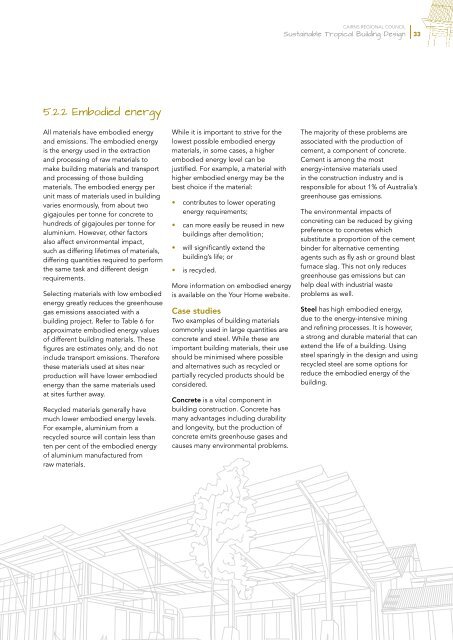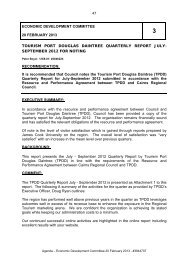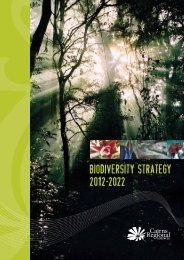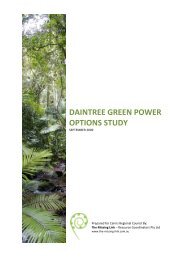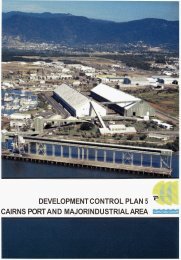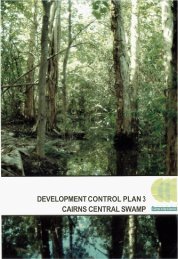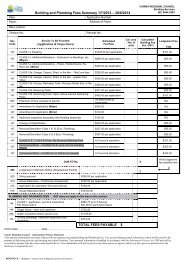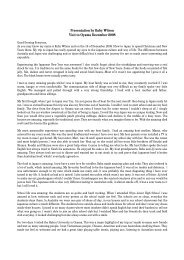SuStainable tropical building deSign - Cairns Regional Council ...
SuStainable tropical building deSign - Cairns Regional Council ...
SuStainable tropical building deSign - Cairns Regional Council ...
- No tags were found...
You also want an ePaper? Increase the reach of your titles
YUMPU automatically turns print PDFs into web optimized ePapers that Google loves.
<strong>Cairns</strong> <strong>Regional</strong> <strong>Council</strong>Sustainable Tropical Building Design335.2.2 Embodied energyAll materials have embodied energyand emissions. The embodied energyis the energy used in the extractionand processing of raw materials tomake <strong>building</strong> materials and transportand processing of those <strong>building</strong>materials. The embodied energy perunit mass of materials used in <strong>building</strong>varies enormously, from about twogigajoules per tonne for concrete tohundreds of gigajoules per tonne foraluminium. However, other factorsalso affect environmental impact,such as differing lifetimes of materials,differing quantities required to performthe same task and different designrequirements.Selecting materials with low embodiedenergy greatly reduces the greenhousegas emissions associated with a<strong>building</strong> project. Refer to Table 6 forapproximate embodied energy valuesof different <strong>building</strong> materials. Thesefigures are estimates only, and do notinclude transport emissions. Thereforethese materials used at sites nearproduction will have lower embodiedenergy than the same materials usedat sites further away.Recycled materials generally havemuch lower embodied energy levels.For example, aluminium from arecycled source will contain less thanten per cent of the embodied energyof aluminium manufactured fromraw materials.While it is important to strive for thelowest possible embodied energymaterials, in some cases, a higherembodied energy level can bejustified. For example, a material withhigher embodied energy may be thebest choice if the material:• contributes to lower operatingenergy requirements;• can more easily be reused in new<strong>building</strong>s after demolition;• will significantly extend the<strong>building</strong>’s life; or• is recycled.More information on embodied energyis available on the Your Home website.Case studiesTwo examples of <strong>building</strong> materialscommonly used in large quantities areconcrete and steel. While these areimportant <strong>building</strong> materials, their useshould be minimised where possibleand alternatives such as recycled orpartially recycled products should beconsidered.Concrete is a vital component in<strong>building</strong> construction. Concrete hasmany advantages including durabilityand longevity, but the production ofconcrete emits greenhouse gases andcauses many environmental problems.The majority of these problems areassociated with the production ofcement, a component of concrete.Cement is among the mostenergy-intensive materials usedin the construction industry and isresponsible for about 1% of Australia’sgreenhouse gas emissions.The environmental impacts ofconcreting can be reduced by givingpreference to concretes whichsubstitute a proportion of the cementbinder for alternative cementingagents such as fly ash or ground blastfurnace slag. This not only reducesgreenhouse gas emissions but canhelp deal with industrial wasteproblems as well.Steel has high embodied energy,due to the energy-intensive miningand refining processes. It is however,a strong and durable material that canextend the life of a <strong>building</strong>. Usingsteel sparingly in the design and usingrecycled steel are some options forreduce the embodied energy of the<strong>building</strong>.


